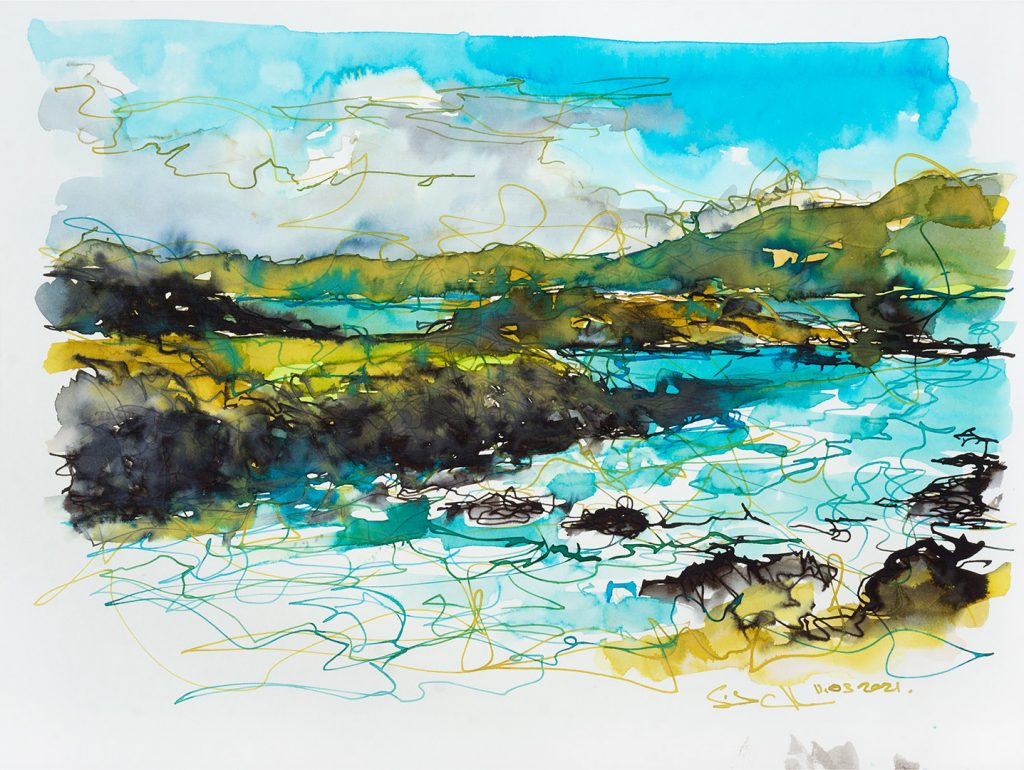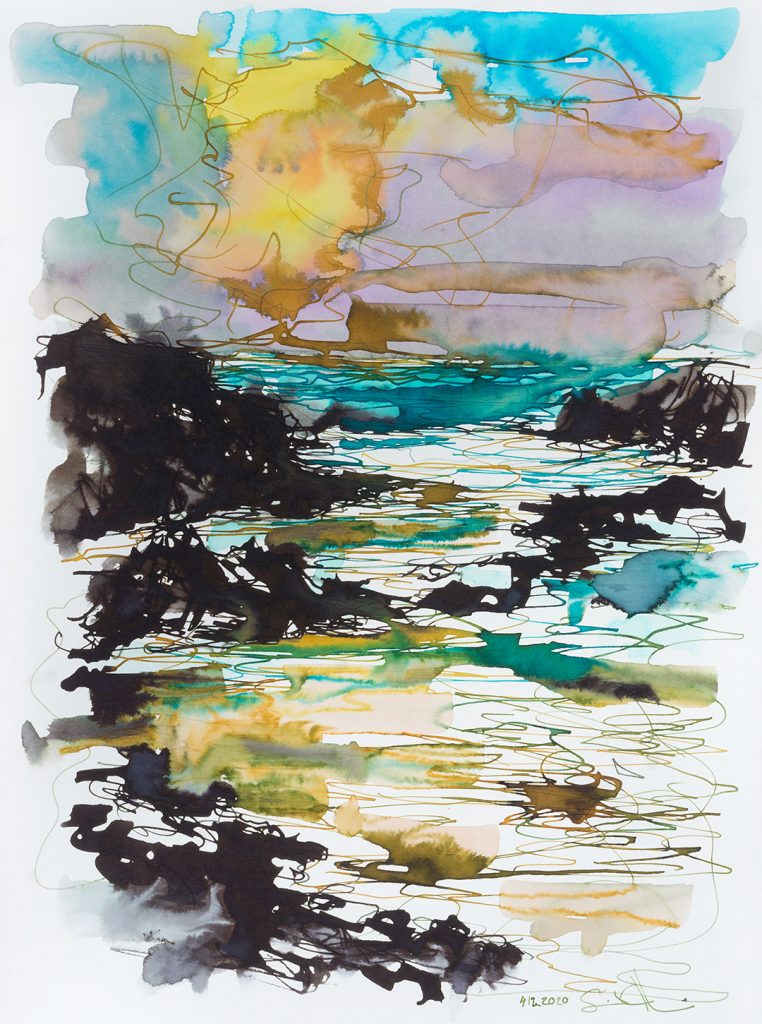“If I don’t create something soon I’m going to go mad! ” These are the words of a friend recently expressing frustration at not having regular time for creativity in her life. There was a sense of passion and urgency about her plea, that got me thinking about how and why creativity is good for us.
When I was a teenager I would set up complex still-life compositions and sit for hours immersed in observing tiny details, and drawing them patiently with a favourite 2B pencil. I remember one composition in particular included a Waterford crystal vase sitting on a mirror: I spent weeks absorbing the intricate detail of the light on the glass and the reflections in the mirror. I was a stressed out, shy teenager and these quiet timeless spaces of immersion brought me to a place of centred, peace and calm that helped me deal with those turbulent years.
Throughout my life, along with exercise, good diet and meditation, a regular creative practice, that has included: drawing, painting, dancing, making and designing has been a staple re-centring practice for me; it has been fundamental to my physical, mental and emotional wellbeing. I believe it is really important, if not essential, for all of us to have our creative outlets.
“A study of 50,000 people found that regardless of skill level, taking part in activities like painting, pottery or music helps people manage their emotions, build confidence and explore solutions to problems.” Chris Sharratt
1 Good for your body
Our bodies are made to move and types of creativity like dancing and anything that gets us outdoors e.g. gardening or nature photography are good for our physical fitness and can help maintain cardiovascular health. Dancing is shown to improve our co-ordination, and can be successfully used as part of a rehabilitation and recovery process e.g. improving the shoulder movement and body image of breast cancer survivors.
2 Boosts your immune system
Playing and listening to music can stimulate the hypothalamus and the amygdala: the regions of the brain associated with mood and hormonal regulation and the body’s response to inflammation. Creative writing has been proven to boost the immune systems of people undergoing HIV treatment: showing an increase in CD4+ lymphocyte count, which are important for the functioning of the immune system and are targeted by the immunodeficiency virus.
3 Reduces stress
Often we can feel like our minds are full of mental clutter and the process of creating can bring our minds, our thoughts and so too our mental and physical states into a place of greater order, which can bring a sense of calm. Creativity can help reduce the production of stress hormones such as cortisol, reducing that push to ‘do’, and bringing us back into the present moment in the same way that mindfulness and meditation practice can. This aids in the release of ‘happy hormones’ such as dopamine, that increase our sense of well-being.
Dealing with the unknown is particularly stress-inducing and a creative practice allows us to become accustomed to dealing with not knowing: creativity comes from ‘no-where’ and we can learn to trust, let go and allow inspiration to arise. Again in a similar way to the practice of mindfulness or meditation we can create the opportunity for contemplation: allowing space to assess plans and problems using journaling, expressive writing, brain dumping, mind mapping and vision boarding.
4 Good for your brain
Music, theatre and acting in particular increase connectivity between the parts of our brain that engage divergent thinking with those used for convergent thinking: allowing for increased lateral thinking and cognitive functioning, greater problem solving capabilities and improved memory recall: so creativity also can make you smarter!
5 Good for your mental health
Studies have shown that participation in visual arts can help reduce depression, and a regular creative practice can help boost positive emotions and keep negative emotions at bay. Creativity can be a way of learning how to process challenging emotions or experiences and teach us how to self-regulate. Studies show that long-term work with expressive writing is proven to be beneficial in healing trauma.
Expressing non-verbally through drawing, writing, theatre, sculpture etc can be a way of making sense of our experiences. Through this expression we can gain different perspectives and become a witness to our shared humanity. And creativity teaches us that you can’t force the process: you can’t force creativity or change any more than you can force a seed to grow. There are times when you need to rest and restore.
6 Increases self esteem
Another way that we can use creativity is as a means of self-development: working with creativity at all ages has been proven to bolster confidence and build self-esteem. Releasing ourselves from the need to do things perfectly and working on activities that create a result can bring a sense of satisfaction and fulfilment.
7 Increases connection
Working with creatively can foster connection between our head, hands and heart, allowing for increased empathy and compassion. In working with others it can create connection and new ways of relating and fostering a sense of belonging. Dancing can keep us young: increasing social engagement, reducing a sense of isolation and depression, and stimulating cognitive function. It helps us overcome barriers and face fears, and has been shown to delay cognitive decline and reduce dementia and Alzheimer’s in the elderly: helping to tap into their personalities and sharpen the senses.
8 Builds neural pathways
For children, creativity is an essential part of their development; it is important to learn through play, learning from ‘failure’ and re-iteration: falling down, getting back up and trying again. This helps build new neural pathways in the brain and encourages exploration and individual expression, acceptance of difference, seeing from different perspectives and the possibility of co-creation.
9 Gives a sense of purpose
The creative process is a way of harnessing hope; it can give us a sense of purpose and focus. In the face of something we are passionate about, a challenge that we have to overcome, we can engage our creativity to come up with ideas alone or with others to engage change. Beautiful examples include community groups such as the GIY movement, men’s sheds, ‘stitch and bitch’ groups and the creativity we have seen in the last year and a half with new and creative ways for communities and groups to stay connected online.
10 Good for our future
Creativity is good for our individual wellbeing, and what benefits our wellbeing also benefits our world. Right now our world is experiencing increasing environmental stress and climate chaos and many sectors of society are experiencing record levels of stress and anxiety. Imagine what would be possible if we all became involved in creative practices that are good for our bodies, heart and minds, imagine the positive and inspiring creative solutions that could emerge. I believe we are all born creative with the potential to harness our imagination and creative energy to create the future we want for the generations to come.
Creativity is a powerful resource for wellbeing: it can keep you fit, regulate stress, improve our cognitive abilities, build confidence, help make sense of the world, solve problems, be an aid in learning and recovery, it helps us to stay connected and young at heart and can and can give us purpose, meaning in life, tools for change and hope for a brighter future.
We all engage in creativity in our own unique ways and for our own reasons, the most important thing is to find something that you are passionate about, dedicate some time for it and let yourself enjoy it. Try to make a little time for yourself for creativity this week: take off the pressure and just let yourself doodle, daydream, make, draw, bake etc. If you are struggling to create time for yourself and would like a safe space and some time for your own creative practice you can come along to my online Creative nest sessions.
Wishing you a beautiful week.



